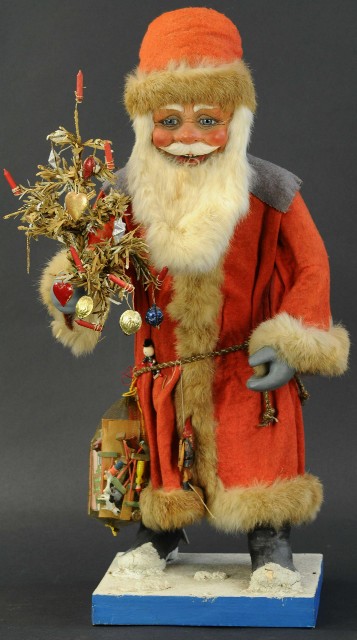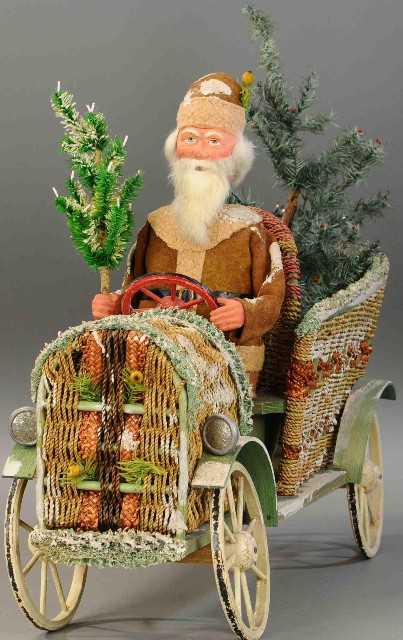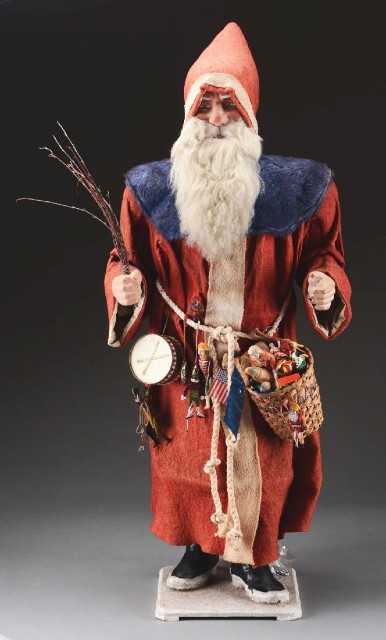
NEW YORK – For many passionate Christmas collectors, moderation is not a word in their vocabulary. There’s always room for one more ornament, one more Nutcracker and for those who collect nodders, there’s room – somewhere – for one more.
Clockwork Santa nodders are some of the most quintessential Christmas collectibles and they hold a special place in the globalization of Christmas. When the American Colonies sought independence, they made a break from the traditions of England, and that included Christmas. The Christmas season in England historically lasted for up to two weeks with families relaxing with each other from Christmas to Twelfth Day (Jan. 6). Even today, that time of relaxation typically stretches to five days. By comparison, Christmas in the New World instead was originally an understated celebration, but over the years, the holiday became big and highly marketable. German imports of Christmas decorations were marketed here, quickly found favor and are still highly sought after.
These nodders, most standing about 30 inches tall, were primarily made as displays to go in store windows, stimulating business by luring shoppers inside. They debuted around the late 1800s and were made well into the 20th century. The early ones had clockworks inside that were wound with a key, enabling the head to nod up and down. Some were later electrified. They are desirable to collectors and often hold pride of place when people set up holiday decorations in their homes.

The most common of them is Santa, or Father Christmas, usually standing and often holding a wicker basket or bag of toys. They were generally made of composition or papier-mache. Santa’s beard and the trim on his robes were crafted using real rabbit fur.
Santa is often depicted wearing red robes but sometimes can be seen wearing camel-colored robes and with different fur trim. A rare German nodder, large at 34 inches tall, having a cardboard tube body with composition hands, feet and head, brought $5,500 at Bertoia Auctions in November 2017. It featured a lavender mohair cape. Another unusual example is an early Santa composition nodder having an open mouth showing teeth. It attained $16,000 + the buyer’s premium in October 2019 at Bertoia Auctions.

Elaborately outfitted examples add to the their value. When a nodder Santa is driving a sleigh or a car or even riding an animal that is also a nodder, these bring some of the biggest prices for this genre. Combination candy container/nodders are also desirable and the highest selling one on LiveAuctioneers came in 2010 when Morphy Auctions sold one for $9,000 + the buyer’s premium. This Santa stood 28 inches tall, wore red robes having a blue collar and carried a wicker basket and a small tree.
Some of the more unusual motifs among German nodders include a key-wound Santa nodder driving a wicker delivery car and holding a candle-lit feather tree that sold for $9,500 in November 2019 and a nodding Santa in a sleigh being pulled by a nodding reindeer, measuring a combined 43 inches long, that made $11,000 + the buyer’s premium in November 2017, both at Bertoia Auctions.

Santa riding on animals that also are nodders are very desirable, such as a Santa astride a donkey, 20½ inches tall, that took $4,000 + the buyer’s premium at Bertoia Auctions in May 2020.
German Christmas items overall made from the late 1800s through the mid-1900s were renowned for their high quality and craftsmanship. After World War II American firms began making Christmas items in mass, taking a bite out of the European export market. Demand remains high today, though, and collectible nodders, often labeled “made in Western Germany,” continue to be collected and cherished.

Santa nodders minus the clockwork mechanisms do not fetch close to the same price as the clockwork versions but are still quite collectible. Usually bedecked in glitter (red, gold or silver are some of the commonly seen examples), German glittery nodders made in a roly-poly style and having pointy hats were made circa 1950s and are charming. Spring-operated, they range in size from about 9 to 15 inches tall.
Holiday antiques have a strong following with Christmas and Halloween practically tied for the lion’s share of the market. The best condition pieces will bring the highest prices but if Santa nodders are your thing, there are fine examples still out there. They don’t come to market all that often so keep on the lookout or set up online alerts for when they do.



